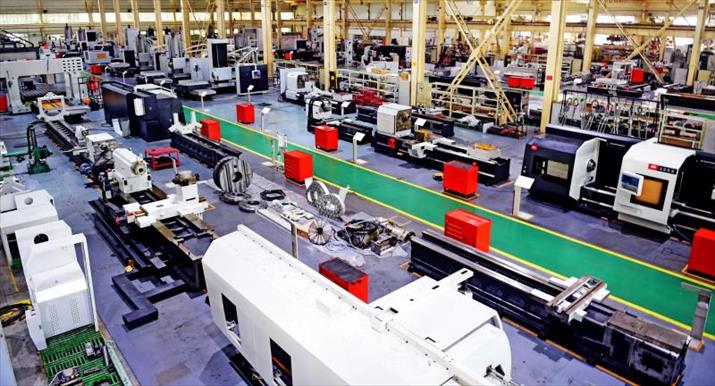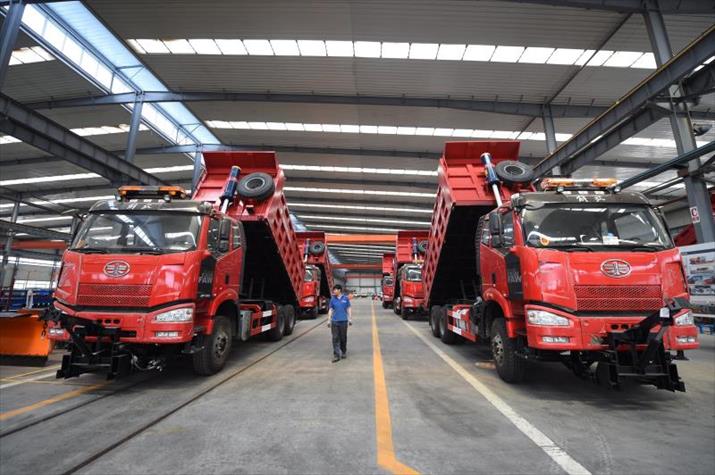| Business |
| Golden Chance for Prosperity | |
| The northeast's partnership with more developed regions will aid its revival | |
|
|
 An automated workshop of Shenyang Machine Tool (Group) Co. Ltd. in Shenyang, capital of Liaoning Province (XINHUA)
China's northeastern region, once the nation's heavy industry hub, has suffered stagnant economic development since the late 1990s. Regional economic performance, although greatly improved in 2016, remains less than satisfactory, and revival of the region's three provinces—Liaoning, Jilin and Heilongjiang—still has a long way to go. In late March, the State Council, China's cabinet, unveiled a fresh move aimed at buffing up this region. One-on-one partnerships are to be established between the three provinces and three economically developed provinces in east and south China, as well as between four northeastern cities and four economically flourishing cities. According to the plan, provincial partnerships will be set up between Liaoning and Jiangsu, Jilin and Zhejiang, and Heilongjiang and Guangdong; while pair-up cooperation will be created between the cities of Shenyang (Liaoning) and Beijing, Dalian (Liaoning) and Shanghai, Changchun (Jilin) and Tianjin, and Harbin (Heilongjiang) and Shenzhen in Guangdong. The work plan comprises 18 specific tasks in the four areas of institutional innovation, industrial restructuring, boosting entrepreneurship and building cooperation platforms. As part of a broader strategy to revitalize the northeast, this new plan is a policy innovation, as it aims to coordinate development and create benefits for both the northeast and its more developed partners instead of simply providing one-way assistance or poverty alleviation. Under the plan, exchanges and regular training of officials will play a significant role in emancipating northeastern residents' mindset to embrace market economy concepts.  A staff member examines heavy trucks produced by a subsidiary of Xuzhou Construction Machinery Group Co. Ltd. in Fuxin, Liaoning Province, on May 11, 2016 (XINHUA)
An innovative move Zhou Jianping, Director of the Department of Northeastern Region Revitalization at the National Development and Reform Commission (NDRC), described the partnerships as examples of enclave economies, a development pattern which aims to coordinate economic development and complement resources through inter-regional management and cooperation. "It is based on the evaluation of the resources, industrial foundations, development levels and present cooperation arrangements in involved provinces and cities," he said at a press briefing on the new work plan which took place in Beijing on March 21. According to the NDRC, the northeastern region boasts abundant natural resources, a good industrial foundation, strong capabilities in science and technology, and huge room for development. The eastern and southern provinces and cities, meanwhile, have a more mature market economy system, in addition to abundant capital and buoyant private enterprises. "Therefore, they are complementary in many fields. Under this new partnership model, governments can voluntarily carry out pragmatic and mutually beneficial cooperation," said Zhou, adding that the partnerships are not exclusive and other regions are welcome to join in. According to the new work plan, the concrete measures include the temporary assignment of provincial officials with rich experience and knowledge of market economy principles from the east and south of the country to the northeast, and regular training sessions for civil servants and employees of enterprises. Such steps are vital for transforming planned economy thinking into a market economy mindset so that the northeast can become more competitive and innovative. They will also provide more opportunities for people in the northeast to acquire advanced ideas and business formats, including about the government's role in social and economic affairs, which could help spur local development. Successful industrial demonstration parks in eastern and southern provinces and cities are encouraged to establish branches in the northeast to introduce advanced experience, professional managers and innovative institutions. The new industrial parks are expected to attract more competitive companies and help form industrial clusters in the region. China has implemented three rounds of revitalization of the northeast since 2004. According to Fu Cheng, head of the Institute of Sociology at the Jilin Academy of Social Sciences, in the first two rounds, the Central Government made preferential policies for the region and expected it to fix problems by itself. Now the revival plan has been upgraded by giving the region the opportunity to have positive interactions with more developed eastern and southern regions, Fu said. "The three northeastern provinces have much to learn from the economically developed provinces, which have accumulated rich experience over the past three decades of reform and opening up and have better understanding of development, effects of policy incentives and market rules," Fu told Beijing Review. Fu said benefits also go the other way. "The northeastern region has much to offer to the eastern and southern regions as well," Fu argued. "For instance, it has an advanced cultural sector and many prestigious universities from which hundreds of thousands of students graduate each year." "Moreover, as the first region in China to complete industrialization, the northeast has a lead in many manufacturing sectors, such as the automobile industry in Changchun and equipment manufacturing in Liaoning. Their expertise in these areas and accumulated experience in setting up joint ventures with foreign companies could be learned by their counterparts in other regions," he said. He also said that exchange of government officials between the northeast and more developed regions is of great significance. "Many problems in the northeast are caused by local officials' outdated thinking." Fu said that implementation of the new work plan should be prevented from becoming ineffectual. "There were personnel exchanges in the past, but they were nothing but a mere formality. This time, sincere exchange of proven and tested development concepts should be guaranteed in order to ultimately change the northeastern region's outdated models of growth," he said.
More to do Over recent years, the Central Government has issued a number of plans to revive the northeast. The region's development lost steam in the 1990s because of China's economic transition and reform of state-owned enterprises (SOEs), and its lackluster economic performance has since continued. The latest data from the National Bureau of Statistics show the three provinces differ in terms of economic growth. In 2016, the GDP of Heilongjiang and Jilin respectively increased by 6.1 percent and 6.9 percent, similar to the national average of 6.7 percent, whereas that of Liaoning shrank by 2.5 percent. In the first two months of 2017, the industrial value added of the northeast increased by a meager 0.8 percent, much lower than the national average of 6.3 percent, while fixed assets investment in the region declined by 17.8 percent year on year, compared to the national average of 8.9-percent growth. A lack of dynamic private businesses is also a major concern for the northeast. A recent ranking of the top 500 private businesses in China released by the All-China Federation of Industry and Commerce contained only 10 enterprises from the northeast, whereas Zhejiang, Jiangsu and Guangdong each have nearly 100 firms on the list. To ease the downward pressure, the government has endeavored since 2004 to revitalize the regional economy and encourage reforms. In the past decade, at least 11 central government documents have specified preferential policies for the region. "Previous rounds of revival policies have yielded considerable results. Without those policies, the three northeastern provinces would have been left far behind in economic performance," Fu said. The region's economy, however, is far from satisfactory. What are the reasons? One possible explanation is the shortage of outstanding entrepreneurs and other people clued up about how the market economy works. After several decades during which the economy was centrally planned, the older generations in the northeast tend to be overcautious in private businesses and reform. Such behind-the-times thinking obstructs the development of private businesses, one of the major driving forces of China's economy. "To reverse the outdated notions about the market economy of the local governments and people is at the heart of efforts to revive this region," said Xiang Tao, a professor at the Northeastern University in Shenyang. Furthermore, while the region has a strong need for skilled laborers, the population of the three northeastern provinces has been shrinking in recent years due to net outward migration and comparatively low fertility rates. High-caliber workers have drained from the three provinces due to the slowing regional economy, and this has in turn undercut local growth. According to NDRC data, from 2010 to 2015, approximately 240,000 people moved away from the three provinces to other regions in pursuit of better job opportunities and a more comfortable climate. "Therefore, improving local people's ideas about the market economy and trying to introduce more excellent professionals is crucial," said Zhao Chenxin, NDRC spokesman, at a press conference held in Beijing last December. "The quickening outflow of university graduates, top-notch technicians and management personnel should draw attention from central and local governments. More measures should be released to help keep these talented people in the region." According to Fu, SOEs account for a large proportion of the northeastern economy. Most locally administered SOEs have encountered difficulties in recent years, such as in dealing with social security funding shortages and resettlement of laid-off workers. In addition, as the region's population is quickly aging, the provincial pension deficits are expanding, and it's unrealistic to expect the region to fix this problem by itself. If the Central Government could give more support in these areas, it would help the development of the northeast in a big way. Fu pointed out that local governments always rigidly carry out state policies. As part of future reforms to streamline administration and delegate power to lower levels, more autonomy should be given to the three northeastern provinces so that they have more flexibility to act in accordance with local conditions. "The Central Government should be patient with this new revitalization attempt to allow a time window for the northeastern economy to gradually adjust itself, make changes and let market forces kick in," Fu said. Copyedited by Chris Surtees Comments to zhouxiaoyan@bjreview.com
|
|
||||||||||||||||||||||||||||||
|
